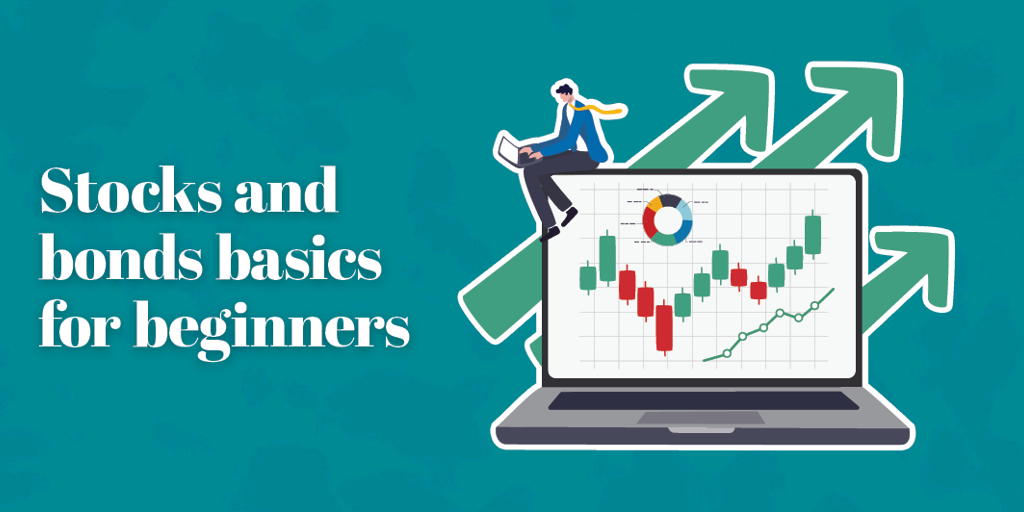


Stocks and bonds for beginners
Investing remains one of the cornerstones of a strong financial foundation. It might feel confusing now, but learning how to invest is achievable and rewarding.
With a huge list of technical terms and an overwhelming number of online teaching resources, investing is complicated. What’s a stock? What’s a bond? What’s a trade? What does it mean when the market crashes? Honestly, the questions go on, and on, and on. Still, stocks and bonds are a great place for people to make extra income without having to work overtime to do it, but investing does come with some risks.
What is the stock market?
The stock market is a place where shares, or a portion of company ownership, are bought, sold, and traded among the public. You buy shares of a stock, but the terms are often used interchangeably.
As the value of the company increases, the value of the stock or share also increases. The basic idea of making money on the stock market is to buy a share of stock now in a company that is growing and profitable. As an owner of the stock, you become a small owner of the company and can sell the stock later when its value increases for more than what you paid. Of course, as an owner, if the company doesn’t grow or isn’t profitable, the value can go down and you lose the money you used to buy it.
Defining stocks
Public stock is stock in a public corporation that’s available for the public to buy. There are two types:
- Common stock gives the buyer partial ownership of a company. This means that the company and the buyer make and lose money equally. Purchasing common stock also gives the buyer the right to vote on company matters such as corporate policy and leadership.
- Preferred stock gives the investor a certain percentage of the money a company makes each year. For example, someone may buy a preferred stock for $25 that has a 10% yield. At the end of each year, they’ll get $2.50.
Defining bonds
There is often confusion around bonds, but the concept of a bond is very simple. A bond is simply a giant loan, chopped up into typically $1,000 pieces and then sold to the public. For example, let’s say a company needs to borrow $10,000,000 to build a new factory. They might decide to use a bond offering to borrow the money.
Creation of a bond
When a bond is created, an issuing bank uses its expertise to set the structure of the bond.
- The bank determines the term (time to maturity).
- The bank determines the rate of interest based upon the creditworthiness of the borrower.
- The bank then sells the bonds to investors in $1,000 pieces.
These bonds can be bought and sold by investors, but the terms and structures never change.
Why invest in the markets?
Investing is one of the most effective ways to save enough money for a comfortable retirement. Retirement funds, like traditional and Roth 401(k)s and IRA plans, are investment accounts that make money through the stock market. These funds create a reliable and tax-efficient pathway to retirement. Because of the tax benefits, it’s wise to contribute as much as you can to a 401(k) or IRA – even the maximum amount – before delving into other types of investing.
Investing in stocks and bonds can be a good way to make the most out of your extra cash, but it isn’t guaranteed you’ll make money. Investing always comes with risk, and the best way to minimize risk is to put your money into stable investments over a long period of time. You won’t double your money in a day, but over time, even a 10 percent yearly return can add up to a lot of extra money. In fact, there is a quick rule of thumb that highlights just how powerful long-term growth can be.
The rule of 72
The rule of 72 states that you can roughly determine how quickly your account will double by dividing the annual return percentage by 72. If an account grows at 10% per year, every year, it will double in value every 7.2 years. If it grows at 7.2% per year, it will take roughly 10 years to double. Steady growth and patience are the key to long-term investment success.
If you have questions about stocks or bonds, contact one of F&M Trust’s wealth management specialists.
Warren Hurt is Chief Investment Officer for F&M Trust.
Recent Articles
Join our e-newsletter
Sign up for our e-newsletter to get new content each month.






















